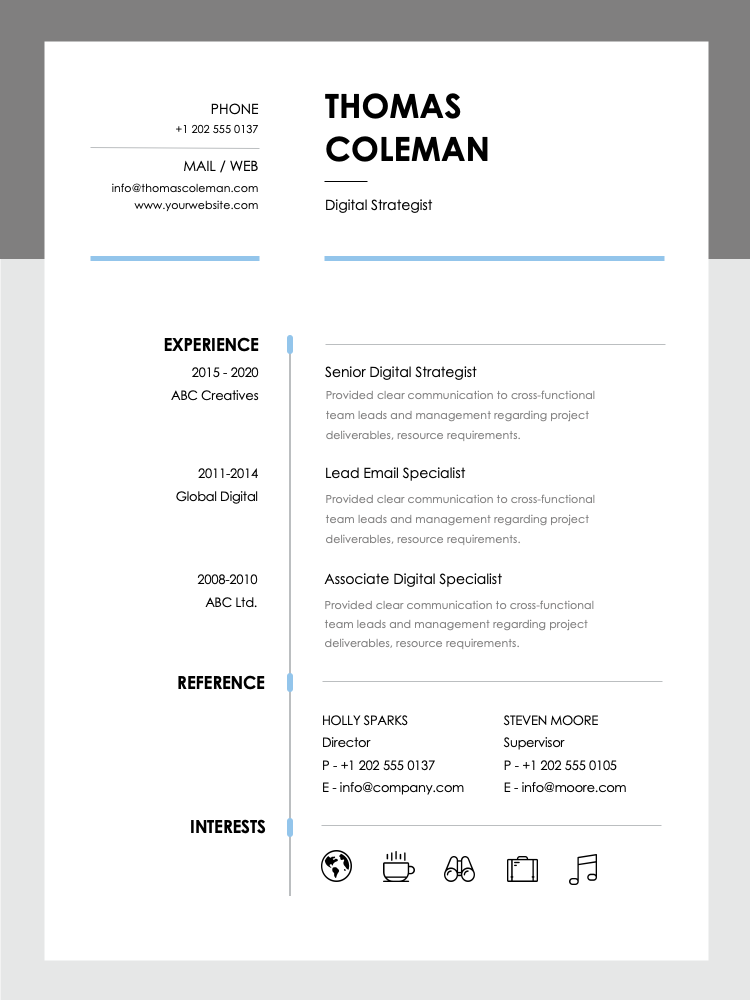Synopsis
Stand out from the crowd and land your next big opportunity with our Resume Collection (Part 1). Choose from a wide selection of designs, from traditional to creative, to easily highlight your professional achievements. Edit and design your resume in PowerPoint, then export it as a .pdf file to print or for electronic distribution.
Slide highlights
Use this slide to decide on your resume format, layout, theme and design. Stick to neutral colors, legible fonts and clean layouts, and consider matching the feel of your information to the aesthetics and culture of the company you're applying to. Other things to consider: space it out, so your resume has some "white space" and is easy to read; add some shadows to make your resume "pop" and incorporate your personal brand in your resume and cover letter.
This slide demonstrates a layout, ideal for showcasing creative work. Ideally, your work experience should be a carefully-curated "exhibit"of relevant projects. Think carefully about which of your creative projects to showcase in a way that's relevant to your desired creative job. However, you may also choose to include a link to an actual portfolio of your work to give a recruiter or hiring manager a better feel of your artistic side.
Overview
In sum, a resume is an overview of your career, whether it's still in the early stages or is extensive. Your resume should be ideally one page-long (two is acceptable under certain circumstances), and demonstrate the roles you've held and currently are in, the duties you've performed, the experiences, abilities and knowledge you've developed and the soft skills you can bring to your next potential place of employment.
Application
The experts from The Muse, a career advancement platform, list the following steps for creating a perfect resume:
- Provide your basic information – this includes your full name (ideally, your name that's visible across the web), your phone number and your personal email address.
- Add your work experience – you have a choice to list your "Work Experience" under one category or it can be broken up into "Relevant Experience" and "Additional Experience" to highlight the jobs that are most relevant for hiring managers to see.
- Consider sharing volunteer work or other experience – anything from a side gig to volunteer work and special projects can be included under labeled sections ("Volunteer Experience" or "Activities"), The Muse experts say.
- Include information about your education – most applicants usually include their school, graduation year, major, minor and degree. You may also choose to include relevant courses you took and the certificates you earned.
- Top it off with some skills and interests – a quick list of skills, software knowledge and interests help a recruiter to see if your skill set and passions align with what they're looking for in a candidate. And it's a super applicant tracking system (ATS) friendly.
- Add a resume summary statement (if applicable) – although not very common, resume summaries can be useful to include near the top of your resume to add clarity or context to your document.
- Tailor it to the specific job – once your "master" resume is ready, it's important to go back to the job description and ensure that what your resume says matches up with the kind of candidate the employers are looking for.
Expert advice
Career Coach, Kim Black, says that the advantage of using PowerPoint when developing a resume is that you are not limited to the traditional rules of resume design, and this can be really beneficial for creative industries that value unique application materials with a creative flair.
Black recommends these three tips for someone working on a resume in PowerPoint:
- Research popular layout and designs and add your unique flair
- Always have a complementary resume in Word or PDF format in case the employer uses a traditional ATS
- Test how your resume looks in multiple formats and browsers.
































